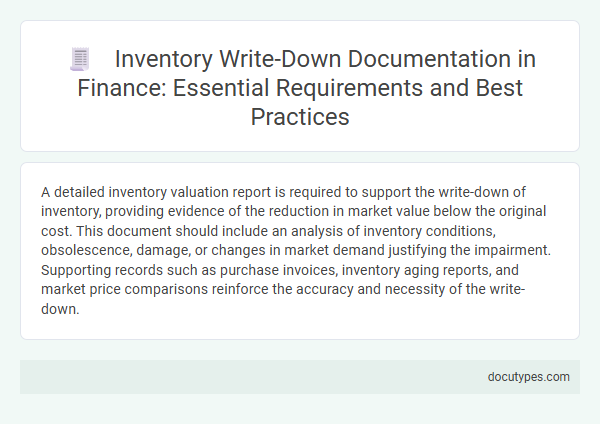A detailed inventory valuation report is required to support the write-down of inventory, providing evidence of the reduction in market value below the original cost. This document should include an analysis of inventory conditions, obsolescence, damage, or changes in market demand justifying the impairment. Supporting records such as purchase invoices, inventory aging reports, and market price comparisons reinforce the accuracy and necessity of the write-down.
Introduction to Inventory Write-Downs in Finance
Inventory write-downs occur when the market value of inventory falls below its recorded cost, necessitating financial adjustments. Proper documentation is crucial to justify the reduction in inventory value and maintain accurate financial records. Supporting documents typically include inventory valuation reports, market price assessments, and internal memos detailing the reasons for the write-down.
Key Reasons for Inventory Write-Downs
Inventory write-downs require proper documentation such as detailed inventory valuation reports, evidence of physical damage or obsolescence, and management approval records. Key reasons for inventory write-downs include market price declines, inventory spoilage, and technological obsolescence reducing the item's net realizable value. Maintaining accurate supporting documents ensures compliance with accounting standards and helps justify the adjustment in financial statements.
Regulatory Framework and Compliance Standards
Supporting the write-down of inventory requires adherence to specific regulatory frameworks and compliance standards to ensure accuracy and accountability. Proper documentation is essential to validate inventory valuation adjustments in financial reporting.
- Inventory Valuation Reports - Detailed records showing the current market value compared to the book value of inventory items are necessary to justify the write-down.
- Audit Trail Documentation - Comprehensive logs including dates, responsible personnel, and decision rationale provide traceability and compliance with regulatory requirements.
- Compliance with GAAP or IFRS - Documentation must align with Generally Accepted Accounting Principles or International Financial Reporting Standards to meet legal and financial standards.
Properly maintained documentation ensures transparent financial reporting and supports regulatory compliance during inventory write-down processes.
Essential Documentation Requirements
Supporting a write-down of inventory requires clear, accurate documentation to validate the reduction in value. Essential documents include detailed inventory count records and market value assessments.
Write-down justification must be backed by purchase invoices showing original costs and current market analysis demonstrating obsolete or damaged inventory. You need inventory aging reports and internal memos explaining the reason for the impairment. Proper documentation helps ensure compliance with accounting standards and audit requirements.
Steps for Accurate Inventory Valuation
Accurate inventory valuation requires proper documentation to support any write-downs, ensuring compliance with accounting standards. Key documents include inventory count sheets, cost records, and market value assessments that justify the reduced value.
Steps for accurate inventory valuation start with a thorough physical inventory count and verification of quantities. Next, compare the recorded cost with the net realizable value to determine the need for write-downs, supported by detailed documentation like supplier invoices and market price lists.
Internal Controls for Write-Down Authorization
Proper documentation is essential to support the write-down of inventory in finance. Strong internal controls ensure write-downs are authorized, documented, and accurate.
- Inventory Valuation Report - Provides detailed assessment of inventory value declines requiring write-down.
- Written Authorization - Approval from designated management verifying the justification for the write-down.
- Inventory Adjustment Form - Formal record of changes in inventory value, supported by evidence and authorized signatures.
Supporting Evidence: Invoices, Reports, and Records
What document is required to support the write-down of inventory? Proper supporting evidence includes invoices, inventory valuation reports, and detailed records documenting the condition and market value of the inventory. These documents validate the necessity for the write-down by providing clear, auditable proof of inventory impairment or obsolescence.
Best Practices for Consistent Documentation
Supporting documentation for inventory write-downs is essential to ensure accuracy and compliance with accounting standards such as GAAP and IFRS. Maintaining consistent records prevents discrepancies and supports audit trails for financial reporting.
- Inventory Valuation Reports - Detailed reports showing current inventory values versus market value to justify the write-down amount.
- Obsolescence Analysis - Documentation of inventory aging, damage, or obsolescence to demonstrate the reason for reduced value.
- Management Approval Records - Signed authorization from finance or management confirming the write-down decision and amount.
Audit Trail Creation and Retention Policies
Supporting the write-down of inventory requires detailed documentation such as inventory valuation reports, audit adjustment records, and management approval forms. These documents create a clear audit trail that verifies the accuracy and necessity of the write-down.
Audit trail creation involves maintaining dated records showing the reduction reason, adjustments made, and authorization by relevant personnel. Retention policies mandate keeping these documents for a specific period, typically 5 to 7 years, to comply with regulatory requirements and facilitate future audits.
What Document Is Required to Support the Write-Down of Inventory? Infographic

